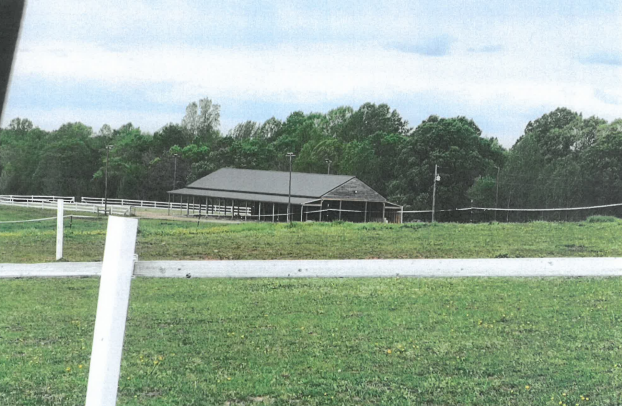Cobbs Creek ordinance revisited
Published 3:38 pm Thursday, May 30, 2019

- Pictured is the reservoir buffer and watershed map dated October 2015. The reservoir normal pool area is at the center of the circle, the reservoir buffer is located between the normal pool and the other reservoir watershed area, and the other reservoir watershed area is located on the outside of the reservoir buffer.
Officials in Cumberland will be one step closer to finalizing its watershed protection ordinance through a series of meetings scheduled for June and July.
Planning & Zoning Director J.P. Duncan, during a meeting May 20, gave members of the Cumberland County Planning Commission a draft of the ordinance and a map to review prior to a workshop scheduled for Monday, June 10.
The planning commission is set to schedule a public hearing about the ordinance Monday, June 24.
Should the members of the planning commission make a recommendation at the June 24 meeting, the Cumberland Board of Supervisors could consider the ordinance during its Tuesday, July 9, meeting, which would be the last meeting that County Administrator and Attorney Vivian Seay Giles will serve on the Cumberland County Board of Supervisors, Giles said.
Duncan said he gave the paperwork to commission members early “so we can hit the ground running when we discuss it at the workshop meeting.”
A memorandum of understanding between Cumberland County and Henrico County was established in 2010, and Henrico began the first phase of building its reservoir in 2015.
The reservoir is estimated to cost a total $280 million. The reservoir would collect water from the James River in order to secure Henrico’s drinking water supply for approximately five decades, according to documentation from Henrico County’s website.
Henrico began paying the county an annual contract payment of $1.13 million in lieu of taxes in 2011.
The $280-million reservoir project is expected to permanently impact 15.3 miles of stream, almost 31 acres of wetlands and 4.6 acres of open water according to the original permit for the reservoir issued by the Virginia Department of Environmental Quality (DEQ).
The reservoir will permanently impact 15.3 miles of stream, almost 31 acres of wetlands and 4.6 acres of open water.
The Henrico County Attorney’s office previously submitted a draft ordinance to Cumberland for their review, Duncan said. The planning commission held a workshop on the draft on June 12, 2017, and held a second workshop on Sept. 11, 2017.
The draft of the ordinance Duncan provided to The Herald is dated May 5, 2017.
The ordinance cited that Cumberland County would have jurisdiction of the reservoir and would be responsible for enforcing the ordinance.
“The purpose of this ordinance is to achieve water quality protection; to control and abate the discharge of pollutants; to permit beneficial use of the Cobbs Creek Reservoir; and to safeguard potential future use of the reservoir as a direct source of drinking water for Cumberland County,” the draft ordinance cited.
According to the draft ordinance, the planning and zoning director would determine the boundaries of the reservoir buffer and other reservoir watershed area based on the October 2015 reservoir buffer and watershed map.
The reservoir buffers, according to the map, outlines the reservoir pool, where the water is located. Activities prohibited on the reservoir buffer include constructing new buildings, structures, fences, roads or utilities; industrial or commercial activities; damming, impounding, capturing or diverting flowing water; operating any motorized vehicles and pasturing or grazing any livestock or poultry.
Uses permitted for the reservoir buffer area include facilities that support the water supply project; expansion, repair, or relocation of septic or drinking water systems when required by the Virginia Department of Health law or regulation; reconstruction of existing buildings, structures, fences, roads or utilities damaged by natural events if the original dimensions and locations are maintained; burning or harvesting timber or otherwise removing vegetation when necessary for safety purposes or for fire, pest or invasive species control.
According to the ordinance, prior approval from Henrico County will be required before a private landowner undertakes any burning, harvesting or removal of vegetation. Other permitted uses include blasting, mining or performing other earth-disturbing activities for upland borrow activities for construction of the water supply project; installation of billboards, signs, or towers necessary for operation of the water supply project and pasturing or grazing livestock or poultry within an existing fenced or otherwise enclosed area that is already being used for such activity.
Concerning the other reservoir watershed area, which is also located outside the buffer pool, prohibited uses include manufacture, bulk storage, or any type of distribution of petroleum, chemical, asphalt products, or any hazardous substances defined by the Comprehensive Environmental Response, Compensation and Liability Act of 1980; installation of long distance transmission pipelines for natural gas, liquid petroleum, petroleum products, slurry coal, and any other liquids or solids, except water lines, sewer lines and storm sewers; gas stations and/or automotive service stations; junkyards; exploration, development or operation of oil wells, natural gas wells, strip mines or quarries; application to land surfaces or landfilling of industrial, commercial or residential waste and discharges into the storm drainage system or state waters of any pollutants or waters containing any pollutants other than stormwater.
Permitted uses for the other reservoir watershed area include anything not explicitly prohibited in the ordinance.
Uses prohibited in the reservoir normal pool include all activities prohibited in the reservoir buffer and other reservoir area; use of sailboats and jet skis; use of boats with outboard engines exceeding 10 horsepower; swimming; littering or polluting the reservoir; use of firearms or explosives; fishing tournaments involving prizes and accessing or mooring at dam facilities.
Duncan said it would be up to the planning commission and the board of supervisors to definitively recommend or enact any changes to the ordinance.






